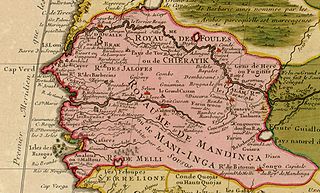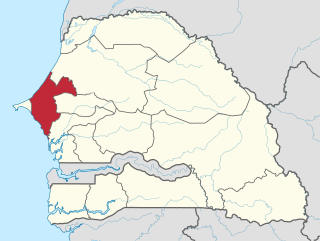
The history of Senegal is commonly divided into a number of periods, encompassing the prehistoric era, the precolonial period, colonialism, and the contemporary era.

Thiès is a region of western Senegal. The capital is also called Thiès.

Fatick is the southwest region of the northern outcrop of Senegal. Its alternative name is Jinnak Bolon. The region is named for its capital city, Fatick.

Tivaouane or Tivawan is a city and urban commune located in the Thiès Region of Senegal.

Fatick department is one of the 46 departments of Senegal, one of the three departments making up the Fatick region, and lies on the road between Mbour and Kaolack. The Fatick region is home to many Sereer people ; the Sereers are one of the major ethnic groups in Senegal and there are four Sereer dialects. At least 99% of the regional area consists Seereer, notably of Seereer Niominka people, and less than 1% of migrant Fulbe.

The Serer people are a West African ethnoreligious group. They are the third-largest ethnic group in Senegal, making up 15% of the Senegalese population. They also reside in northern Gambia and southern Mauritania.

The Kingdom of Sine was a post-classical Serer kingdom along the north bank of the Saloum River delta in modern Senegal.

The Saltigue, are Serer high priests and priestesses who preside over the religious ceremonies and affairs of the Serer people, such as the Xooy ceremony, the biggest event in the Serer religious calendar. They usually come from ancient Serer paternal families, and the title is inherited by birthright. In Serer country, Saltigue are always diviners.
The Serer religion, or A ƭat Roog, is the original religious beliefs, practices, and teachings of the Serer people living in the Senegambia region in West Africa. The Serer religion believes in a universal supreme deity called Roog. In the Cangin languages, Roog is referred to as Koox, Kopé Tiatie Cac, and Kokh Kox.
Guelowar, also spelled Gelwar, Guelwar, Guelware, Gueleware or Gueloware, was a maternal dynasty in the pre-colonial Serer kingdoms of Sine and Saloum. They were from the Mandinka ethnic group. The offspring of Mandinka women and Serer men became the kings of Sine and Saloum. The dynasty lasted from the mid-14th century to 1969, the year both kings died.

Joof or Diouf is a surname that is typically Serer. This surname is also spelt Juuf or Juf.
Diakhao is a small town and commune in the Fatick Region in the west of Senegal.
Lamane Jegan Joof, was a Serer lamane who according to Serer tradition founded the Serer village of Tukar now part of present-day Senegal. The Raan Festival takes place each year at Tukar, two weeks after the appearance of the new moon in April.
Maad a Sinig Maysa Wali Jaxateh Manneh was a king described in the oral tradition of the Serer pre-colonial Kingdom of Sine and the first of the Guelowar maternal dynasty to rule in Serer country. He reigned as Maad a Sinig from c. 1350 to 1370.

Lingeer Fatim Beye Joos Fadiou was a 14th-century Serer princess and queen (Lingeer) from the Kingdom of Sine. She is the matriarch and early ancestor of the Joos Maternal Dynasty of Waalo. She is usually regarded by some sources as the founder of the Joos Maternal Dynasty. The pre-colonial Kingdoms of Sine and Waalo now lies within present-day Senegal. Her surname is Beye (English-Gambia) or Bèye (French-Senegal). Joos Fadiou is her maternal clan. In Serer, "Fa-tim" means "the maternal clan of..."
Tattaguine is a town in the west of Senegal. It is also the name of the rural community.

The Joos Maternal Dynasty was a Serer maternal dynasty which originated from the Serer pre-colonial Kingdom of Sine in the 14th century and spread to the Wolof Kingdom of Waalo. The matriarch or founder of this maternal dynasty was Lingeer Fatim Beye, a princess and queen originally from the Kingdom of Sine. In Waalo, it was founded by the princess Lingeer Ndoye Demba of Sine. Lingeer Ndoye Demba was the maternal granddaughter of Lingeer Fatim Beye. They both came from the Serer ethnic group. The pre-colonial Kingdoms of Sine and Waalo now forming a part of modern-day Senegal maintained good relations with other pre-colonial kingdoms.
Serer maternal clans or Serer matriclans are the maternal clans of the Serer people of Senegal, the Gambia and Mauritania. The Serer are both patrilineal and matrilineal. Inheritance depends on the nature of the asset being inherited – i.e. whether it is a maternal asset which requires maternal inheritance or paternal asset requiring paternal inheritance (kucarla). The Serer woman play a vital role in royal and religious affairs. In pre-colonial times until the abolition of their monarchies, a Serer king would be required to crown his mother, maternal aunt or sister as Lingeer (queen) after his own coronation. This re-affirms the maternal lineage to which they both belong (Tim). The Lingeer was very powerful and had her own army and palace. She was the queen of all women and presided over female cases. From a religious perspective, the Serer woman plays a vital role in Serer religion. As members of the Serer priestly class, they are among the guardians of Serer religion, sciences, ethics and culture. There are several Serer matriclans; not all of them are listed here. Alliance between matriclans in order to achieve a common goal was, and still is very common. The same clan can be called a different name depending on which part of Serer country one finds oneself in. Some of these matriclans form part of Serer mythology and dynastic history. The mythology afforded to some of these clans draws parallels with the Serer creation narrative, which posits that: the first human to be created was a female. Many Serers who adhere to the tenets of Serer religion believe these narratives to contain profound truths which are historic or pre-historic in nature.
Babacar Sedikh Diouf or Babacar Sédikh Diouf is a Senegalese historian, author, researcher, campaigner against "Wolofization", a Pan-Africanist, and former teacher. He has written extensively about the history and culture of Senegal, Africa, and that of the Serer ethnic group to which he belongs. He usually writes by the pen name Babacar Sedikh Diouf.
The Xooy is a Serer divination ceremony held once a year in Fatick, Senegal. The Xooy is one of the most important and well known ceremonies in the Serer religious calendar, and is a national event in Senegal's cultural calendar which attracts government officials and dignitaries. The ceremony is held yearly at the Centre MALANGO in Sine, Senegal and attracts a large crowd from Senegal, and Serers from neighbouring Gambia and the diaspora. It is somewhat of a yearly pilgrimage. The Lebou also attend the ceremony in homage to their Serer ancestors. The Lebou genies are actual the Serer pangool. The Xooy takes place around late May early June before the rainy season where the Serer high priests and priestesses—the Saltigue dressed in their traditional gowns and hats takes centre stage to divine the future. There is a master of ceremonies, and as the public are seated in a circle, each Saltigue enters the circle in turn and give their divination on matters relating to the weather, politics, economics, health, etc. The ceremony goes on for two days —and throughout the night—accompanied by the rhythm of drums. The Serer people have traditionally been farmers, cattle herders, boat builders and fisher people. The Xooy therefore serves both a religious and agricultural function.









